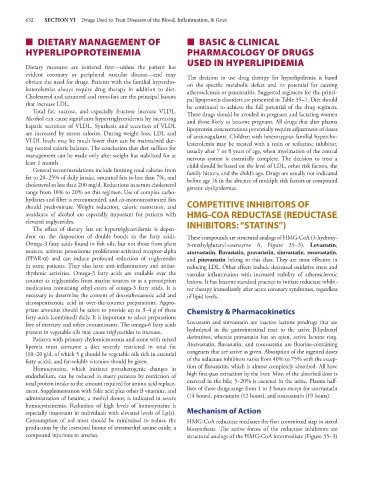Page 646 - Basic _ Clinical Pharmacology ( PDFDrive )
P. 646
632 SECTION VI Drugs Used to Treat Diseases of the Blood, Inflammation, & Gout
■ DIETARY MANAGEMENT OF ■ BASIC & CLINICAL
HYPERLIPOPROTEINEMIA PHARMACOLOGY OF DRUGS
USED IN HYPERLIPIDEMIA
Dietary measures are initiated first—unless the patient has
evident coronary or peripheral vascular disease—and may The decision to use drug therapy for hyperlipidemia is based
obviate the need for drugs. Patients with the familial hypercho- on the specific metabolic defect and its potential for causing
lesterolemias always require drug therapy in addition to diet. atherosclerosis or pancreatitis. Suggested regimens for the princi-
Cholesterol and saturated and trans-fats are the principal factors pal lipoprotein disorders are presented in Table 35–1. Diet should
that increase LDL. be continued to achieve the full potential of the drug regimen.
Total fat, sucrose, and especially fructose increase VLDL. These drugs should be avoided in pregnant and lactating women
Alcohol can cause significant hypertriglyceridemia by increasing and those likely to become pregnant. All drugs that alter plasma
hepatic secretion of VLDL. Synthesis and secretion of VLDL lipoprotein concentrations potentially require adjustment of doses
are increased by excess calories. During weight loss, LDL and of anticoagulants. Children with heterozygous familial hypercho-
VLDL levels may be much lower than can be maintained dur- lesterolemia may be treated with a resin or reductase inhibitor,
ing neutral caloric balance. The conclusion that diet suffices for usually after 7 or 8 years of age, when myelination of the central
management can be made only after weight has stabilized for at nervous system is essentially complete. The decision to treat a
least 1 month. child should be based on the level of LDL, other risk factors, the
General recommendations include limiting total calories from family history, and the child’s age. Drugs are usually not indicated
fat to 20–25% of daily intake, saturated fats to less than 7%, and before age 16 in the absence of multiple risk factors or compound
cholesterol to less than 200 mg/d. Reductions in serum cholesterol genetic dyslipidemias.
range from 10% to 20% on this regimen. Use of complex carbo-
hydrates and fiber is recommended, and cis-monounsaturated fats
should predominate. Weight reduction, caloric restriction, and COMPETITIVE INHIBITORS OF
avoidance of alcohol are especially important for patients with HMG-COA REDUCTASE (REDUCTASE
elevated triglycerides. INHIBITORS: “STATINS”)
The effect of dietary fats on hypertriglyceridemia is depen-
dent on the disposition of double bonds in the fatty acids. These compounds are structural analogs of HMG-CoA (3-hydroxy-
Omega-3 fatty acids found in fish oils, but not those from plant 3-methylglutaryl-coenzyme A, Figure 35–3). Lovastatin,
sources, activate peroxisome proliferator-activated receptor-alpha atorvastatin, fluvastatin, pravastatin, simvastatin, rosuvastatin,
(PPAR-α) and can induce profound reduction of triglycerides and pitavastatin belong to this class. They are most effective in
in some patients. They also have anti-inflammatory and antiar- reducing LDL. Other effects include decreased oxidative stress and
rhythmic activities. Omega-3 fatty acids are available over the vascular inflammation with increased stability of atherosclerotic
counter as triglycerides from marine sources or as a prescription lesions. It has become standard practice to initiate reductase inhibi-
medication containing ethyl esters of omega-3 fatty acids. It is tor therapy immediately after acute coronary syndromes, regardless
necessary to determine the content of docosahexaenoic acid and of lipid levels.
eicosapentaenoic acid in over-the-counter preparations. Appro-
priate amounts should be taken to provide up to 3–4 g of these Chemistry & Pharmacokinetics
fatty acids (combined) daily. It is important to select preparations
free of mercury and other contaminants. The omega-6 fatty acids Lovastatin and simvastatin are inactive lactone prodrugs that are
present in vegetable oils may cause triglycerides to increase. hydrolyzed in the gastrointestinal tract to the active β-hydroxyl
Patients with primary chylomicronemia and some with mixed derivatives, whereas pravastatin has an open, active lactone ring.
lipemia must consume a diet severely restricted in total fat Atorvastatin, fluvastatin, and rosuvastatin are fluorine-containing
(10–20 g/d, of which 5 g should be vegetable oils rich in essential congeners that are active as given. Absorption of the ingested doses
fatty acids), and fat-soluble vitamins should be given. of the reductase inhibitors varies from 40% to 75% with the excep-
Homocysteine, which initiates proatherogenic changes in tion of fluvastatin, which is almost completely absorbed. All have
endothelium, can be reduced in many patients by restriction of high first-pass extraction by the liver. Most of the absorbed dose is
total protein intake to the amount required for amino acid replace- excreted in the bile; 5–20% is excreted in the urine. Plasma half-
ment. Supplementation with folic acid plus other B vitamins, and lives of these drugs range from 1 to 3 hours except for atorvastatin
administration of betaine, a methyl donor, is indicated in severe (14 hours), pitavastatin (12 hours), and rosuvastatin (19 hours).
homocysteinemia. Reduction of high levels of homocysteine is
especially important in individuals with elevated levels of Lp(a). Mechanism of Action
Consumption of red meat should be minimized to reduce the HMG-CoA reductase mediates the first committed step in sterol
production by the intestinal biome of tetramethyl amine oxide, a biosynthesis. The active forms of the reductase inhibitors are
compound injurious to arteries. structural analogs of the HMG-CoA intermediate (Figure 35–3)

